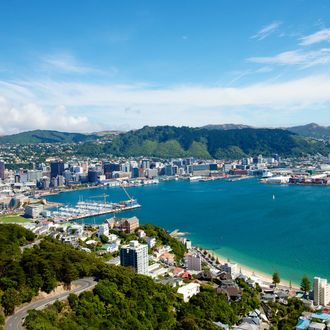
Growing up in one of the most thoroughly landlocked places on Earth (Illinois), the ocean was something I heard about as a kid but didn’t actually meet in person until my parents courageously took my sister and I to the Caribbean. Three-year-old me was frightened (it’s very big), but I was also enamored: Though they thundered, the waves were so calming.
Three-year-old me is deeply satisfied, then, to see a new health geography study of people living in Wellington, the capital of New Zealand. A team of researchers from New Zealand and the U.S. found that living in sight of water (which they call “bluespace”) correlates with having lower levels of psychological stress, even when accounting for income levels. So alert your friends in real estate: There’s yet another reason to bet on ocean views.
In an earlier paper, the same research team found three big reasons living by “green” or “blue” spaces make people healthier: You’re more likely to be physically active; you’re more likely to run into people and talk to them (which is good, because people need to be more social than they realize); and since forests and oceans have relatively little stimulation, they’re easier on the eyes and ears than the honking bloodbath of a New York City street.
Though earlier lab research has shown that images of seascapes are calming, the team — lead by Daniel Nutsford at the University of Canterbury in New Zealand — used real-world data to find the benefit of having the ocean outside your window. Nutsford and colleagues got permission from the New Zealand government to use anonymized health data from the country’s 2011-2012 national health survey. The mental-health data came in the form of the Kessler Psychological Distress Scale, a ten-item questionnaire used to measure large-scale psychological health that yields a 1 to 40 score, with 40 being the most distressed. The researchers plotted residents’ scores against how much their homes offered views of green space or bluespace, calculated by assessing slope, aspect, distance, and elevation with some fancy software.
Having views of the Pacific was significantly associated with lower distress, even when accounting for income and crime (which also predicted lower stress). The researchers say that for every 10 percent increase in the amount of water you can see from your home, you can expect a .28 lower score on the Kessler distress scale. Curiously enough, having views of green spaces — ranging from playing fields to parks — didn’t have such an effect.
The research does have its limitations. While their models accounted for “covariates” like income and safety and the quality of the neighborhood, their data didn’t have access to how long people had lived in a given place. Also, given the cross-sectional nature of the study, it’s difficult to isolate causality: Were chill kiwis drawn to ocean views, or did the views chill the kiwis? Going forward, there are issues of reproducibility. In Wellington — an island city — less than one percent of the water is fresh, so you don’t know if the same could be said for people who live next to lakes, as one does in my native Midwest. Since so many of the world’s great cities are port cities — from Istanbul to Hong Kong to New York — it will be fascinating to see if the same correlation between blue views and chillness can be found elsewhere. (We here at Science of Us would certainly sign up for such a study.)
If the correlation is confirmed, it would help out urban planning: To support the mental health of citizens, optimize for ocean views.




